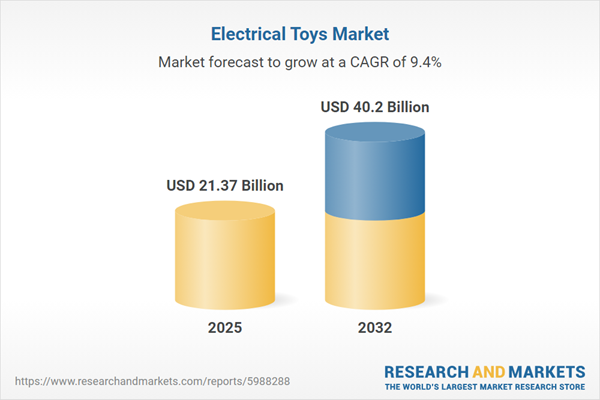Speak directly to the analyst to clarify any post sales queries you may have.
Senior leaders in the electrical toys market are navigating a dynamic landscape shaped by intersecting forces of technology, compliance, and evolving customer needs. Adaptability and strategy alignment are crucial to thriving in this fast-changing B2B sector.
Market Snapshot: Electrical Toys Market Growth and Trends
The electrical toys market reached USD 19.56 billion in 2024 with a compound annual growth rate (CAGR) of 9.42%. Expansion is driven by demand for toys integrating digital play and educational components. Companies focus on technology-forward designs and product multifunctionality to respond to changing buyer preferences, while also gaining market share. Regulatory dynamics require ongoing attention to compliance, improved aesthetics, and sustained product innovation. The increasing emphasis on interactive user experiences, paired with shifting regulations, compels organizations to continually balance creative advancement with operational reliability and scalability.
Scope & Segmentation of the Electrical Toys Market
- Product Types: Educational electronic toys support cognitive growth. Ride-on vehicles offer physical development and social skills engagement. Handheld gaming devices capture digital-native customer interest. Remote control toys, including drones, attract technically oriented users. Robotic toys deliver programming exposure and collaborative experiences for families.
- Distribution Channels: Department stores and specialty retailers provide in-person consultation and direct product evaluation. Brand-owned websites and e-commerce platforms enable flexible digital access, aligning with the increasing shift toward omnichannel purchasing across diverse stakeholders.
- Age Groups: Offerings are specifically designed for age brackets such as 3–5, 6–8, 9–12, and 13+, supporting targeted product development, marketing, and customer engagement at each buyer stage.
- Power Sources: Battery, corded, and solar power feature as key options, reflecting industry commitments to product safety and environmental stewardship, and responding to regulatory and consumer demands for sustainability.
- Technologies: App connectivity, smart features, and voice interaction enrich user engagement and promote market differentiation. Retaining traditional lines maintains value for legacy buyer segments and supports accessibility for budget-conscious customers.
- Geographies: High growth potential is seen in North America and Latin America, meriting focused investments. EMEA and Asia-Pacific require organizations to monitor local cultural needs and compliance standards for successful entry and expansion.
- Key Companies Profiled: LEGO A/S, Hasbro, Mattel, Bandai Namco Holdings, Spin Master, VTech Holdings, MGA Entertainment, Funko, Jakks Pacific, and Razor USA are recognized for driving technology and market development globally.
Key Takeaways for Leaders in the Electrical Toys Market
- Integrating microelectronics and artificial intelligence enables organizations to deliver diverse, differentiated products, which opens new user segments and maintains competitive advantages.
- Accelerated product development structures support rapid adaptation to regulatory changes and evolving consumer expectations, fostering enhanced user experiences and specialized features.
- Robust sourcing and quality management practices reduce operational disruptions and reputational risks in a highly competitive environment.
- Sustainable product choices and strengthened supply chain partnerships fortify enterprise resilience as ecological standards and stakeholder expectations continue to rise.
- Combining digital, retail, and region-specific strategies helps address regulatory complexity and reach a wider range of buyers with tailored go-to-market models.
- Leveraging data from all sales channels allows leaders to anticipate market changes and quickly realign operations accordingly.
Tariff Impact: U.S. Trade Policy and Supply Chain Adjustments
Recent U.S. tariff changes have led manufacturers to re-evaluate sourcing orientations, including nearshoring and boosting domestic production. These strategies are designed to limit supply chain risks, maintain operational stability, and protect profit margins. Leadership teams need to address new distribution challenges and adhere to evolving regulatory requirements prompted by these volatile trade conditions.
Methodology & Data Sources
This report synthesizes comprehensive secondary research, in-depth executive interviews, and current regulatory assessments. Findings are validated by peer-reviewed surveys and statistically rigorous methods, ensuring trustworthy and actionable insights for B2B decision-makers in the electrical toys market.
Why This Report Matters to Electrical Toys Market Leaders
- Supports executives with a framework to steer innovation, anticipate regulatory trends, and strengthen product strategies on a foundation of empirical market intelligence.
- Realigns internal objectives to reflect compliance shifts and buyer expectations, building readiness for emerging risks and growth opportunities.
- Provides region-specific and channel-based insights to refine market-entry practices and reinforce ongoing brand positioning in priority territories.
Conclusion
Sustained innovation and swift regulatory response are essential for continued leadership in the electrical toys sector. Senior leaders who focus on adaptability and compliance position their organizations for lasting success in a competitive arena.
Additional Product Information:
- Purchase of this report includes 1 year online access with quarterly updates.
- This report can be updated on request. Please contact our Customer Experience team using the Ask a Question widget on our website.
Table of Contents
3. Executive Summary
4. Market Overview
7. Cumulative Impact of Artificial Intelligence 2025
Companies Mentioned
The companies profiled in this Electrical Toys market report include:- LEGO A/S
- Hasbro, Inc.
- Mattel, Inc.
- Bandai Namco Holdings Inc.
- Spin Master Ltd.
- VTech Holdings Limited
- MGA Entertainment LLC
- Funko, Inc.
- Jakks Pacific, Inc.
- Razor USA LLC
Table Information
| Report Attribute | Details |
|---|---|
| No. of Pages | 180 |
| Published | October 2025 |
| Forecast Period | 2025 - 2032 |
| Estimated Market Value ( USD | $ 21.37 Billion |
| Forecasted Market Value ( USD | $ 40.2 Billion |
| Compound Annual Growth Rate | 9.4% |
| Regions Covered | Global |
| No. of Companies Mentioned | 11 |









